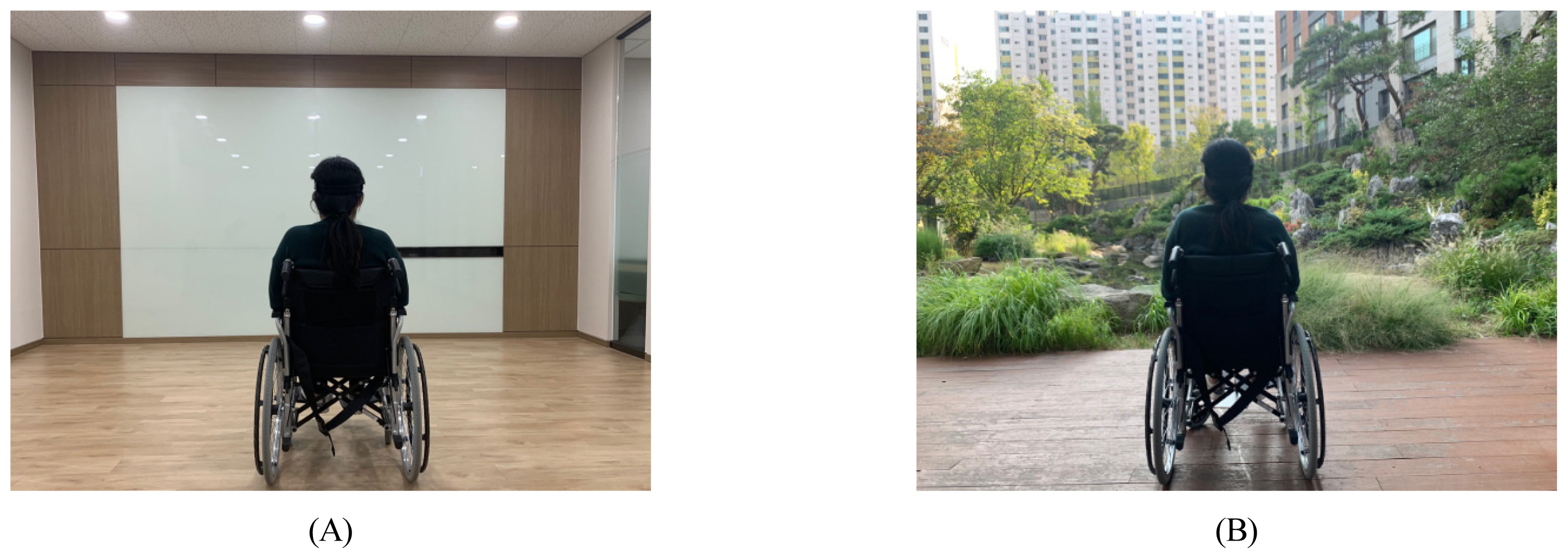 |
 |
- Search
| J. People Plants Environ > Volume 25(3); 2022 > Article |
|
ABSTRACT
Background and objective: With an increasing interest in health-related issues in urban environments, there has been growing attention to the relationship between green space and psychological states of residents in apartment complexes. This study investigated resident perceptions of green space and their stress responses in an apartment complex.
Methods: The psychological stress responses that arose during residents’ observation of two types of environments―an indoor living room and an outdoor green space―were investigated through a field experiment. Sixteen healthy adult females in child care participated in the within-group comparison study. The semantic differential (SD) method was used to examine environmental perception, and three psychological tests were administered to quantify stress responses to the two environments: the Profile of Mood States (POMS), the Revised Perceived Restorativeness Scale (RPRS), and the Zuckerman Inventory of Personal Reactions Scale (ZIPERS).
Results: Feeling of pleasure, familiarity, and beauty showed significantly higher scores in outdoor green space than indoor space. In the POMS analysis, significantly more positive mood states were found in outdoor green space than indoor space. The ZIPERS and RPRS data showed that outdoor green space was more suitable for fatigue recovery because it relieved negative emotions and psychological stress to a greater degree than indoor space.
Conclusion: This field study suggested that green spaces have the potential to reduce psychological stress and restore psychological well-being in female residents. Despite limited exposure to the green space in the apartment complex, improved mood states and positive health-related effects were observed among the participants.
Methods: The psychological stress responses that arose during residents’ observation of two types of environments―an indoor living room and an outdoor green space―were investigated through a field experiment. Sixteen healthy adult females in child care participated in the within-group comparison study. The semantic differential (SD) method was used to examine environmental perception, and three psychological tests were administered to quantify stress responses to the two environments: the Profile of Mood States (POMS), the Revised Perceived Restorativeness Scale (RPRS), and the Zuckerman Inventory of Personal Reactions Scale (ZIPERS).
Results: Feeling of pleasure, familiarity, and beauty showed significantly higher scores in outdoor green space than indoor space. In the POMS analysis, significantly more positive mood states were found in outdoor green space than indoor space. The ZIPERS and RPRS data showed that outdoor green space was more suitable for fatigue recovery because it relieved negative emotions and psychological stress to a greater degree than indoor space.
Conclusion: This field study suggested that green spaces have the potential to reduce psychological stress and restore psychological well-being in female residents. Despite limited exposure to the green space in the apartment complex, improved mood states and positive health-related effects were observed among the participants.
Urban residents account for 91% of the total population in Korea (Statistics Korea, 2020), and the level of psychological stress is increasing as various lifestyles change due to urbanization (Lee, 2020). Stress management has been considered as a major social issue, and much attention is paid to the role of the green environment as a stress reliever. According to a study on the correlation between stress and green space in residential areas, better access to outdoor green space in residential areas led to less psychological stress (Nielsen and Hansen, 2007) and improved mental health (Torres Toda et al., 2020). This implies that green space around residential areas can affect stress recovery of residents, which supports the growing social interest in psychological recovery through green space (Kim et al., 2013). Increased level of stress in daily life due to the COVID-19 pandemic has become a critical issue in health maintenance, and contacting with outdoor green space is perceived as an effective alternative approach to reduce stress (Kim, 2022).
Meanwhile, apartments can be regarded as the most common type of residence in Korea (Ministry of Land, Infrastructure and Transport, 2021). With the growing social needs for a healthy residential environment (Choi, 2021), green spaces in apartment complexes are showing quantitative and qualitative improvement. Green spaces in apartment complexes can affect the quality of life and satisfaction of residents as a space for nature experience (Lee and Chon, 2008), which is also perceived as an important environmental factor in housing market. Studies on the residents’ perception of green spaces in apartment complexes suggested that green landscape could reduce stress(Lee and Lee, 2018), which could largely depend on the landscape structure and psychological feelings of stability and pleasure (Lee, 2016). A study examining the correlation between green landscape in apartment complexes and psychological stress response revealed that green space reduced tension and anxiety and increased positive emotions like vitality (Jeon et al., 2021). Despite these studies, there are still insufficient data available on how green spaces in apartment complexes affect psychological stress relief of residents, with very few cases of empirical studies through field experiment. Thus, the efficacy of green space in apartment complexes often depends not on the experiment-based research but rather on the deductive results based on similar studies. Psychological benefits regarding environmental stimuli can be earned through various cognitive processes such as sight, hearing, and smell. To test the effect of these holistic environmental stimulations, experimental approach through field research is required (Lee et al., 2011; Lee et al., 2012). Therefore, this study was focused on evaluating the impact of green space on psychological stress response and examining the environmental cognition of residents about green spaces in apartment complexes.
To assess how green spaces in apartment complexes affect resident stress, this study selected an apartment complex built within the last 10 years in the metropolitan area as the research site. The site selected was a place with a favorable green environment that won an award related to greening. The outdoor green space in the apartment complex was selected as the experimental site. The experimental site is a space comprised of natural materials such as plants, rocks, and water. To compare with the experimental site, the indoor space within the apartment complex was selected as the control site. The control site is an indoor environment that is similar to a living room where residents spend their everyday life in the apartment (Fig. 1). The experiment was conducted in the fall, and the temperature of the outdoor green space was 28.9 ± 4.1 °C (mean ± standard deviation, hereinafter the same) and the humidity was 55.6 ± 20.8%, while the temperature of the indoor space was 23.7 ± 0.6 °C and the humidity was 73.3 ± 3.5%. The level of illumination was approximately 2,500lx in the outdoor green space, measured on a fine day, and illumination indoors was approximately 280lx, which meets the KS Recommended Levels of Illumination. The outdoor experimental site and indoor control site had a difference in the physical environment, but considering that it is a field study, various environmental elements of each space were perceived and interpreted as one whole stimulation (Cordoza et al., 2018; Lee et al., 2012; Ulrich et al., 2020).
The research subjects were 16 female homemakers (age 38 ± 4.0, mean ± standard deviation) who spend relatively more time within the apartment complex and are healthy without any medical history of physical and mental diseases. Female homemakers spend a comparatively long time in residential space and are more frequently exposed to stress due to the overlapping stress and burden about childcare (Yoo et al., 2020). Before the experiment, the subjects were tested with the Psychosocial Wellbeing Index (PWI) and scored 21.38 ± 1.62 points (mean ± standard error), indicating that they belong to a potential stress group with a relatively high level of stress.
The subjects were to relax comfortably in a sitting position in the outdoor green space and indoor space of the apartment complex, after which the difference in their stress response between the two spaces was examined. The research was conducted total 4 times, between 10 a.m. and 3 p.m., measuring 2 subjects each time so that 8 subjects were measured each day for 2 days of the experiment. First, the subjects received a specific explanation about the details of the experiment in the waiting room, after which they signed the consent form to proceed with the experiment. To minimize the visual effect while moving from one place to the other during the experiment as well as the psychological change due to physical activities, the subjects moved from one place to the other on a wheelchair with their visions blocked with a face shield. Each of the 2 subjects was randomly assigned to the outdoor green space and the indoor space, where they relaxed for 2 minutes and then rested for 5 minutes in a sitting position as they looked at the landscape of the site. All psychological measurements were taken immediately after their rest ended. To crosscheck the outdoor green space and indoor space, the experiment was conducted in one space after the other (Table 1).
Spatial cognition, changes in mood states, environmental stress, and restorative environment levels were examined to measure the stress response in outdoor green space and indoor space. Since the green environment affects mood states and stress recovery based on the characteristics of a person’s spatial cognition, the questionnaires that can quantitatively evaluate these elements were used in this study. These questionnaires are widely used in studies of green environment since they relatively precisely reflect the psychological responses induced by stimulations in a short time.
Cognitive traits of space affect mental state. Semantic Differential (SD) was adopted to investigate spatial cognition (Osgood et al., 1957). With reference to studies on the perception of apartment landscape (Lee, 2016; Lee and Lee, 2018), this study rated 9 items such as ‘artificial-natural’, ‘unpleasant-pleasant’, ‘complex-simple’, ‘closed-open’, ‘unstable-stable’, ‘unfamiliar-familiar’, ‘dirty-clean’, ‘ugly-beautiful’, and ‘cold-warm’ on a 7-point Likert scale. The Profile Of Mood States (POMS) was adopted to determine human moods and emotions due to the environment (Yeun and Shin-Park, 2006). With reference to similar studies that evaluated mood states about the environment (Lee et al., 2014; Lee, 2017), 3 domains such as depression, vigor, and fatigue were rated on a 5-point Likert scale. SD and POMS were used by extracting some of the indicators and scales to minimize the increase of fatigue among the participants, and items that are redundant or similar with other surveys used in this experiment were excluded.
The Zuckerman Inventory of Personal Reactions Scale (ZIPERS) was used to examine the positive and negative emotions toward the environment (Zuckerman, 1977). With reference to a study evaluating psychological stress toward the environment (Kim, 2015), 5 domains such as ‘positive affect’, ‘attentiveness’, ‘fear’, ‘sadness’, and ‘anger’ were rated on a 5-point Likert scale. The Revised Perceived Restorativeness Scale (RPRS) was used to investigate the psychological restorativeness of space (Hartig et al., 1997). With reference to a study that evaluated the environment as a restorative environment (Jang, 2021), 4 domains such as being away, fascination, coherence, and compatibility were rated on a 7-point Likert scale.
The responses to two different landscapes were analyzed by quantifying and comparing psychological indicators when looking at the outdoor green space and indoor space. The psychological data of the participants was statistically tested using SPSS Statistics 21.0 (IBM, USA). Since within-group comparison was applied to the comparison of psychological responses to each landscape, the changes in these responses due to the environmental differences were to be more clearly derived when the groups had homogeneity. The results were obtained using the non-parametric method of Wilcoxon signed-rank test. The numerical values were presented in mean ± standard error, and the statistical significance level was p < .05, p < .01. This study was approved by Public Institutional Review Board (Public IRB) (P01-202111-12-001).
As a result of analyzing the impressions of the participants about each environment to determine the spatial cognition characteristic of outdoor green space and indoor space, a significant difference was found in all items except ‘complex-simple’ and ‘dirty-clean’ (Fig. 2). In particular, ‘unstable-stable’ scored 1.88 ± 0.27 (mean ± standard error, hereinafter the same) in outdoor green space, perceived as a more stable environment than indoor space that scored −1.25 ± 0.35 (p < .01). ‘Cold-warm’ scored 2.19 ± 0.25 in outdoor green space, perceived as a warmer environment than indoor space that scored −0.88 ± 0.34 (p < .01). In addition, the subjects felt that outdoor green space was much more natural, pleasant, and open, and that green space is more familiar and beautiful than indoor space. This environmental cognition seemed to be quite subjective. In terms of familiarity, the subjects claimed that green space was more familiar even though they spent much more time in the indoor living room than in green space. Moreover, even though indoor living room space was more pleasant in terms of temperature and humidity, the ‘pleasant’ score was significantly higher in outdoor green space. Considering this result, it can be implied that such a response is affected not only by meteorological factors such as temperature and humidity but also by landscape quality or environmental cognition characteristics. This cognitive response can be explained by the biophilia hypothesis (Wilson, 2021), showing that psychological stability found in forests (Jeon et al., 2021; Park et al., 2011; Song et al., 2015) can also be found in a small green space surrounded by apartment buildings.
The difference in spatial cognition also had a significant effect on emotional response. As a result of analyzing the mood states about the landscape after relaxing in different spaces (Fig. 3), depression (D) and fatigue (F) (p < .01) showed significantly lower scores in outdoor green space (D, 0.69 ± 0.22; F, 1.56 ± 0.44) than indoor space (D, 5.25 ± 1.25, F, 6.38 ± 1.29). On the other hand, vigor (V) showed a significantly higher score in outdoor green space (9.19 ± 1.35) than indoor space (3.81 ± 0.95). Considering that psychological stress is related to mood states, green spaces in apartment complexes that induce positive cognitive response play a critical role as a space for emotional stability in everyday life. In particular, female homemakers who participated in this study frequently complained of emotional and affective disorders (Kim and Jeong, 2020), which implied that green spaces in apartment complexes can be an environmental alternative for resolving psychological and affective issues.
As a result of analyzing how environmental difference affects stress, a significant difference was found in all items (Fig. 4). ‘Positive affect’ showed a higher score in outdoor green space (15.56 ± 0.66) than indoor space (9.19 ± 0.82) (p < .01). ‘Attentiveness’ also showed a higher score in outdoor green space (8.25 ± 0.25) than indoor space (5.25 ± 0.41) (p < .01). On the other hand, ‘fear’, ‘sadness’, and ‘anger’ showed significantly lower scores in outdoor green space (4.81 ± 0.47, 1.25 ± 0.14, 2.38 ± 0.20) than indoor space (fear, 8.38 ± 0.64; sadness, 2.44 ± 0.26; anger, 4.19 ± 0.42) (p < .01). The results of analyzing RPRS that measures restorativeness from stress also showed that ‘psychologically being away’ showed a significantly higher score in outdoor green space (10.56 ± 0.56) than indoor space (3.50 ± 0.53), indicating a positive psychological response to green space (Fig. 5; p < . 01). ‘Fascination’ showed a higher score in outdoor green space (27.06 ± 1.44) than indoor space (8.06 ± 1.32), indicating that the subjects were more attracted to and fascinated by green space (p < .01). ‘Compatibility’ also scored higher in outdoor green space (26.56 ± 1.62) than indoor space (9.00 ± 1.13), implying that green space is more suitable as a restorative environment (p < .01). ‘Coherence’ did not show a significant difference. This indicates that green spaces in apartment complexes가 psychological stress partially have the environmental conditions (Kaplan and Kaplan, 1989) that not only reduce psychological stressors but also help recover from stress. According to a study that examined brain stress response to a physical environment, stress response such as increased amygdala activity is observed when exposed to an artificial environment (Lederbogen et al., 2011). Considering that green space where this study was conducted is a space where there are both the artificial environment of an apartment building and the natural environment of green space, it can be assumed that the psychological benefits of a certain size of nature can offset the negative impact of the artificial environment. Additional research is required on the specific size or form that may anticipate this effect.
The psychological effect revealed in this study shows that green space in an apartment complex can be used as a space to relieve daily stress. Considering that stress is related to various diseases, and acute and chronic stress in daily life has an adverse effect on health (Fukuda and Morimoto, 2001), resting and relaxing in green spaces in apartment complexes can have a positive effect on promoting the health of residents. As revealed by a study on indoor space that evaluated the post-stress recovery effect (Meuwese et al., 2021), the recovery effect was generally greater when exposed to a natural environment like green space rather than an artificial environment like indoor space. Studies investigating groups that experience high levels of stress also showed similar results (Cordoza et al., 2018; Ulrich et al., 2020). Green spaces in apartment complexes are formed in limited space surrounded by high-rise buildings in many cases, which is why they have different characteristics from public green space like urban parks. Nonetheless, it is inspiring that the results were similar to studies on public green space.
This study conducted a field experiment on apartment residents to assess how outdoor green space directly affects their mentality. As a result of comparing stress responses between outdoor green space and indoor space in an apartment complex, the subjects showed positive environmental cognition and emotional change in outdoor green space even though it was surrounded by buildings, which proved that outdoor green space could be more effective than indoor space for stress recovery. The growing interest in healthy environment increased a social demand for healing landscape in urban residential areas, which led to different types of green spaces in apartment complexes from the past. The results of this study proved that green spaces in apartment complexes have a significant impact on the affective and psychological states of residents and that they can be an environmental alternative for stress recovery.
Psychological studies on public green spaces such as forests or urban parks have been actively conducted in the 21st century. However, insufficient research was reported on private green spaces such as gardens in private apartment complexes. This study can be regarded as a pilot study that has several limitations in generalizing the results in terms of the sample size and universality of study site. Nonetheless, it has significance in that it provided data supporting the new role and social function of green spaces for mental health in apartment complexes. In addition, it is also noticeable that the research was conducted in actual sites where the control of the experimental environment was limited. The need for field research has been raised constantly as an alternative approach that overcomes the methodological limitations of indoor studies, but very few field studies have been reported on the health-related effects of green spaces in apartment complexes using quantitative evaluation.
Considering that apartments are established today as a universal housing type in Korea, additional studies are required on the health-related effects of green spaces with a wide range of sizes and types in apartment complexes, while securing demographic diversity of participant groups. There is also an urgent need to obtain scientific evidence about the health benefits of green space across diverse demographic groups. In the future, academic and social attempts should be made to reevaluate and reinterpret urban green space as an infrastructure for environmental health beyond landscape amenity.
Fig. 2
Comparison of Semantic Differential(SD) scores between indoor and outdoor green (N = 16; *, p < .05; **, p < .01; Wilcoxon signed-rank test).
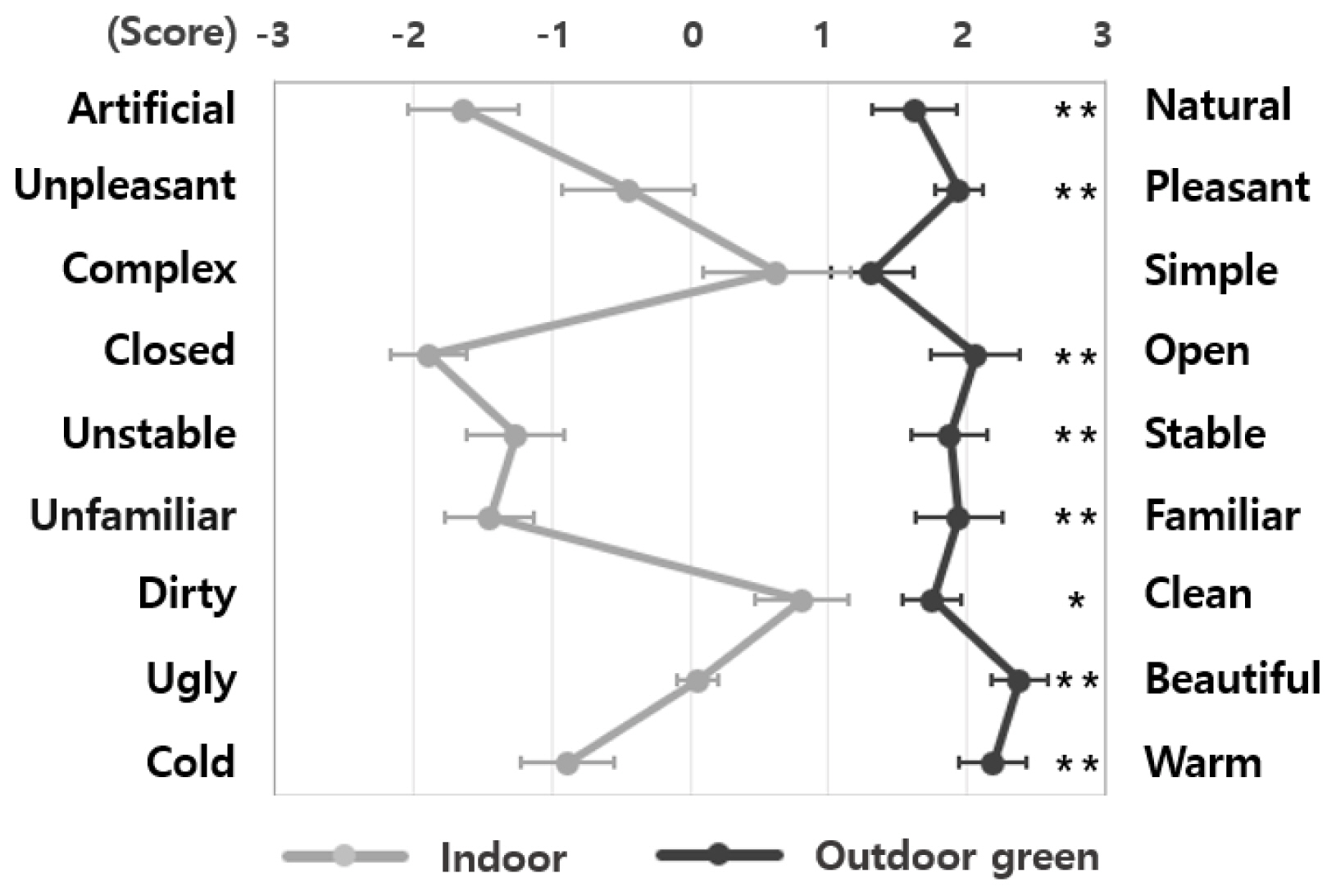
Fig. 3
Comparison of three subscale scores of Profile Of Mood States(POMS) between indoor and outdoor green (N = 16; **, p < .01; Wilcoxon signed-rank test).
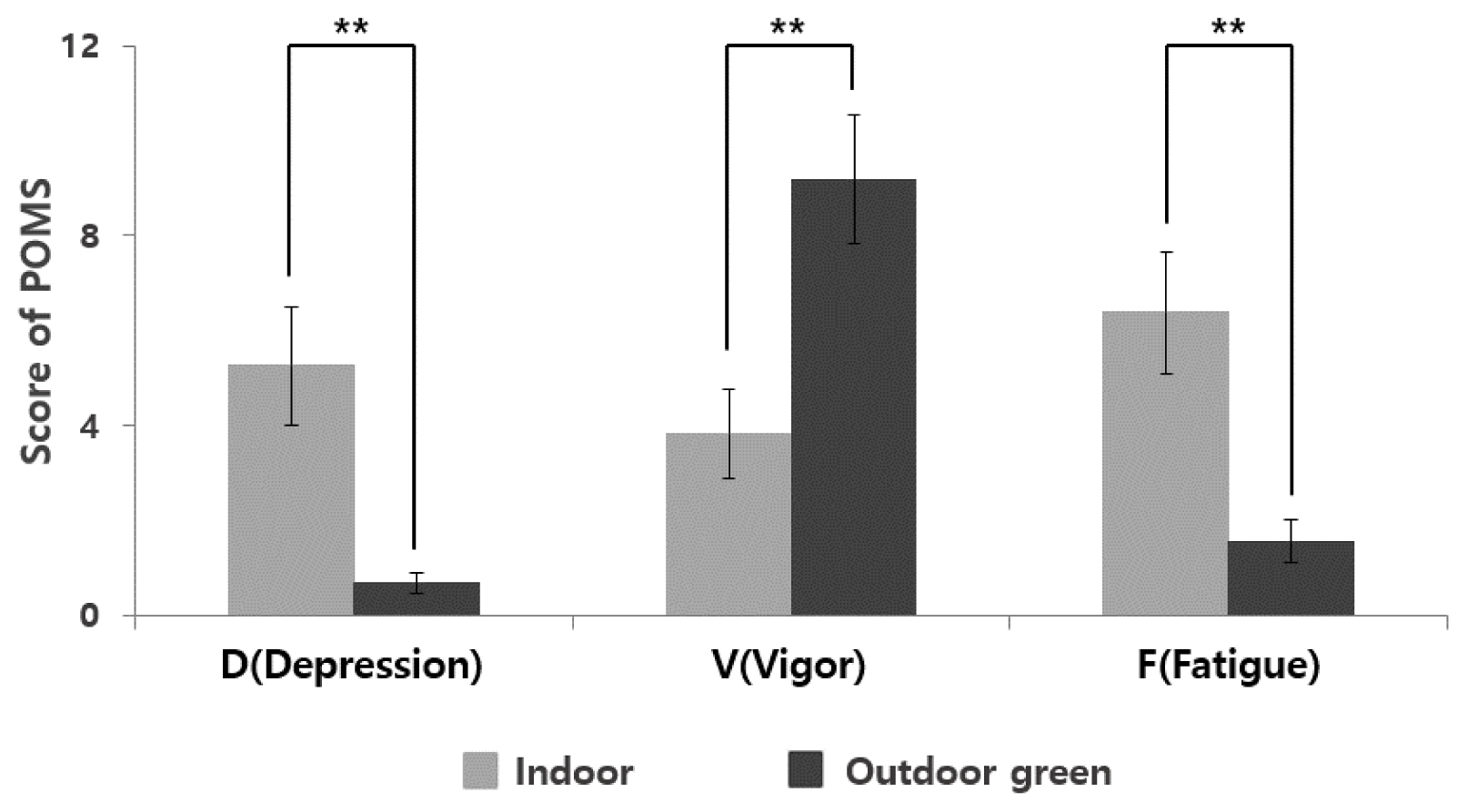
Fig. 4
Comparison of five subscale scores of Zuckerman Inventory of Personal Reactions Scale(ZIPERS) between indoor and outdoor green (N = 16; **, p < .01; Wilcoxon signed-rank test).
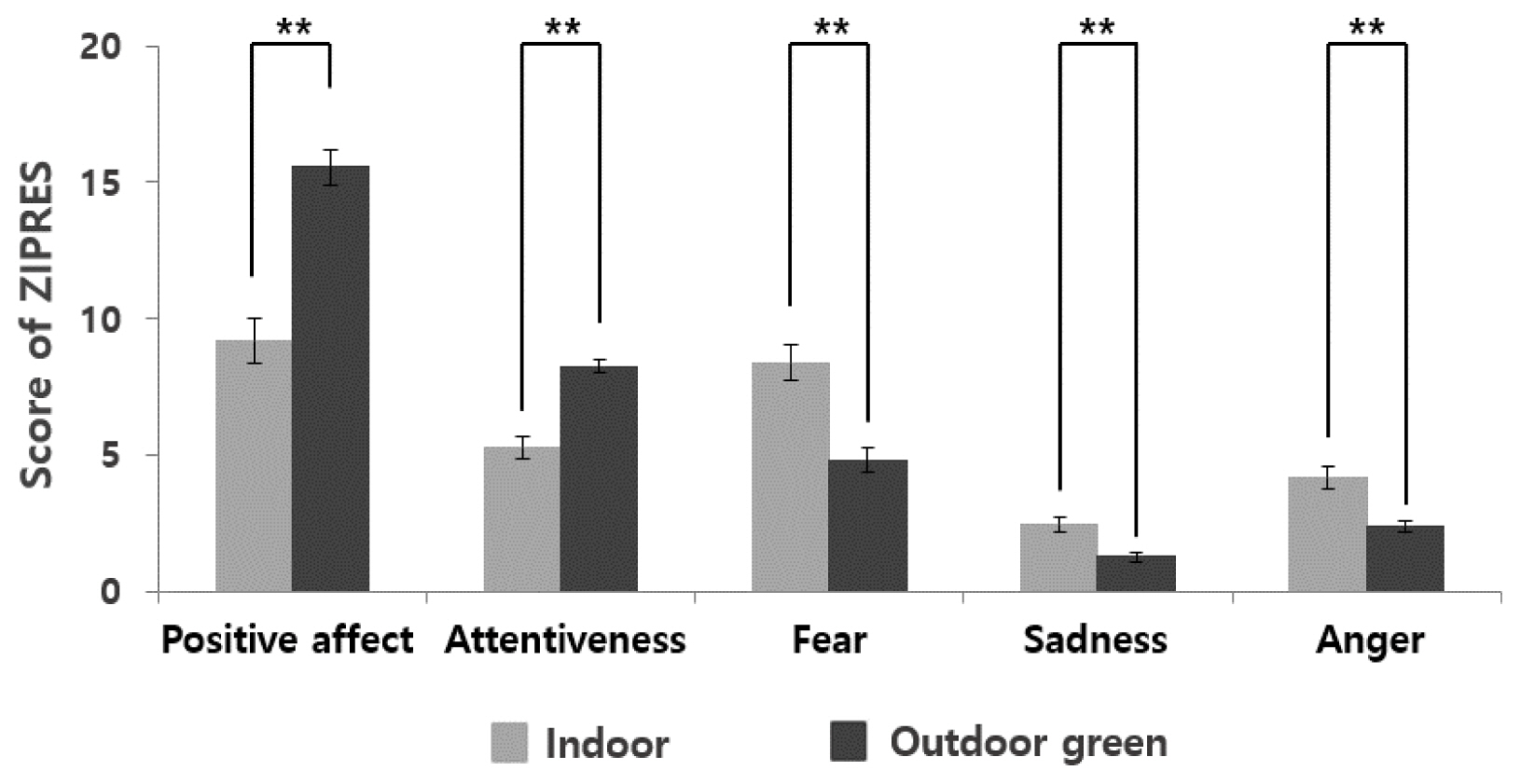
Fig. 5
Comparison of four subscale scores of Revised Perceived Restorativeness Scale(RPRS) between indoor and outdoor green (N = 16; **, p < .01; Wilcoxon signed-rank test).
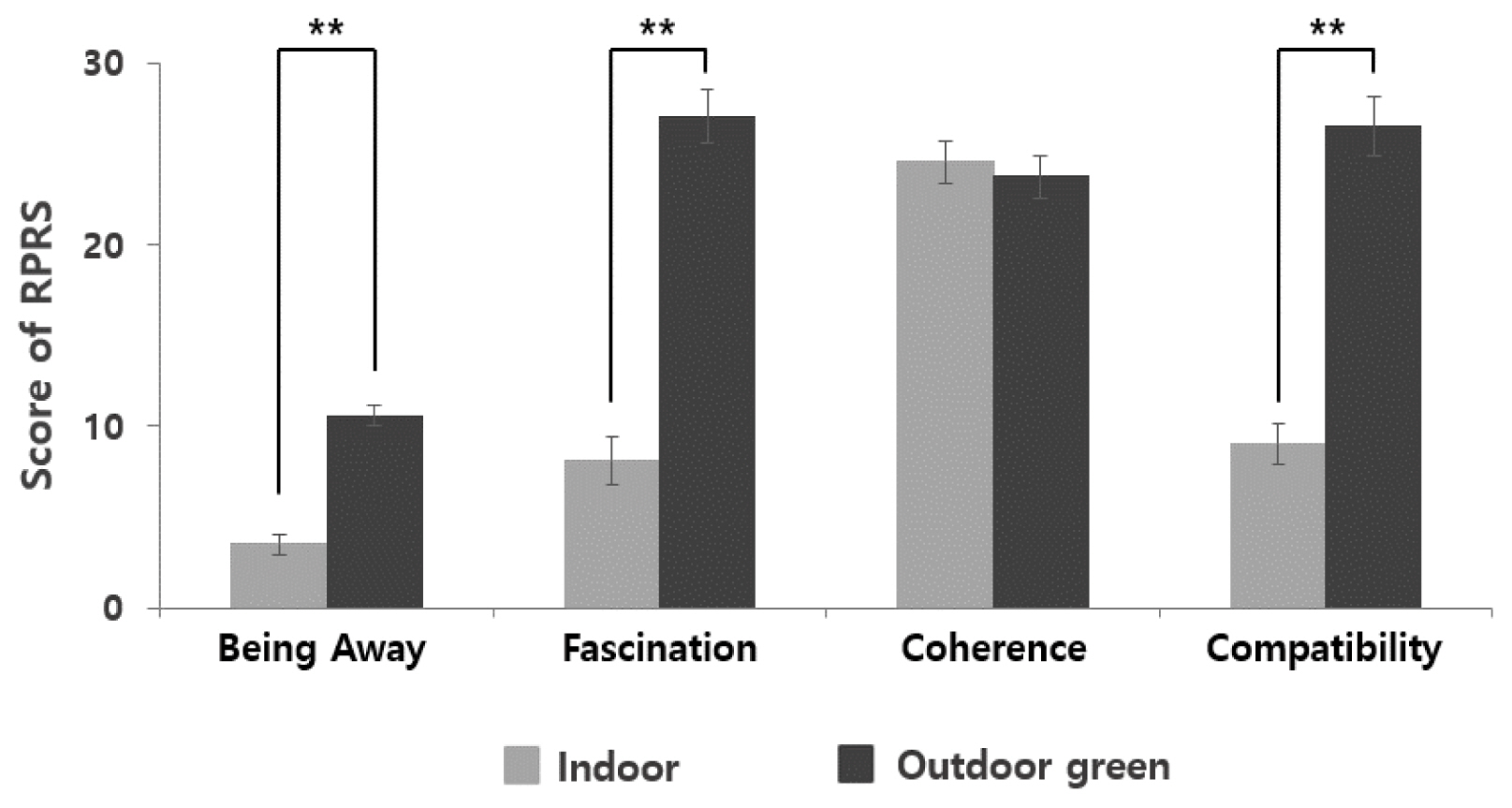
Table 1
Research protocol
References
Choi, JH 2021. Effects of landscape management elements in apartments on their housing satisfaction and brand loyalty. The Journal of the Korea Contents Association. 21(9):245-257.
https://doi.org/10.5392/JKCA.2021.21.09.245

Cordoza, M, RS Ulrich, BJ Manulik, SK Gardiner, PS Fitzpatrick, T Hazen, A Mirka, S Perkins. 2018. Impact of nurses taking daily work breaks in a hospital garden on burnout. American Journal of Critical Care. 27(6):508-512.
https://doi.org/10.4037/ajcc2018131


Fukuda, S, K Morimoto. 2001. Lifestyle, stress and cortisol response: Review II. Environmental Health and Preventive Medicine. 6(1):15-21.
https://doi.org/10.1007/BF02897304



Hartig, T, K Korpela, GW Evans, T Gärling. 1997. A measure of restorative quality in environments. Scandinavian Housing and Planning Research. 14(4):175-194.
https://doi.org/10.1080/02815739708730435

Jang, Y 2021. The Characteristics of Urban Forests as Restorative Environments with the Use of PSDs and RPRS. Doctoral dissertation Seoul National University. Seoul, Korea:
Jeon, SM, MJ Kang, SJ Kim, YJ Kim, HB Choi, J Lee. 2021. Psychological and physiological responses to different views through a window in apartment complexes. Journal of People, Plants, and Environment. 24(5):545-550.
https://doi.org/10.11628/ksppe.2021.24.5.545

Kaplan, R, S Kaplan. 1989. The experience of nature: A psychological perspective New York, USA: Cambridge University, Press.
Kim, JH, WT Kim, YH Yoon. 2013. Beneficial effect of green landscape on relieving stress of citizen in urban area. Korean Journal of Environment and Ecology. 27(4):516-523.
Kim, MH 2015. Behavior settings study based on attention restoration environment perspectives: a case of study of Cheonggyecheon in Seoul. Doctoral dissertation. Seoul National University, Seoul, Korea.
Kim, MJ 2022. The functions of urban open space in terms of the COVID-19 pandemic and women’s child care. Journal of the Korean Housing Association. 33(1):207-216.
https://doi.org/10.6107/JKHA.2022.33.1.207

Kim, YS, BC Jeong. 2020. Study on the effect of the COVID-19 on housewives. The Journal of Humanities and Social science. 11(6):567-578.
https://doi.org/10.22143/HSS21.11.6.41

Lederbogen, F, P Kirsch, L Haddad, F Streit, H Tost, P Schuch, S Wüst, JC Pruessner, M Rietschel, M Deuschle, A Meyer-Lindenberg. 2011. City living and urban upbringing affect neural social stress processing in humans. Natute. 474:498-501.
https://doi.org/10.1038/nature10190

Lee, DH 2016. An analysis of the residents’ landscape psychology with special reference to apartment complex. Master’s thesis. Hanyang University, Seoul, Korea.
Lee, J 2017. Experimental study on the health benefits of garden landscape. International Journal of Environmental Research and Public Health. 14(7):829.
https://doi.org/10.3390/ijerph14070829



Lee, J, Q Li, L Tyrväinen, Y Tsunetsugu, BJ Park, T Kagawa, Y Miyazaki. 2012. Nature therapy and preventive medicine. In: Maddock J, (Eds), Public Health Social Behavioral Health (pp. 325-350). London, UK: IntechOpen.
https://doi.org/10.5772/37701

Lee, J, Y Tsunetsugu, N Takayama, BJ Park, Q Li, C Song, M Komatsu, H Ikei, L Tyrväinen, T Kagawa, Y Miyazaki. 2014. Influence of forest therapy on cardiovascular relaxation in young adults. Evidence-Based Complementary and Alternative Medicine 2014. Article ID 834360. https://doi.org/10.1155/2014/834360

Lee, JA, JH Chon. 2008. Residents’ perceptions of the outdoor spaces of environmentally-friendly apartment complexes. Journal of the Korean Institute of Landscape Architecture. 35(6):1-13.
Lee, JY, KT Park, MS Lee, BJ Park, JH Ku, JW Lee, Y Miyazaki. 2011. Evidence-based field research on health benefits of urban green area. Journal of the Korean Institute of Landscape Architecture. 39(5):111-118.
https://doi.org/10.9715/KILA.2011.39.5.111

Lee, Y, KK Lee. 2018. An analysis of the elements of landscape space in apartment influencing to reduce stress. Journal of Korea Real Estate Society. 36(2):97-109.
Lee, YS 2020. A study on the relationship between urban environmental elements and depression. Journal of Real Estate Analysis. 6(3):69-88.
https://doi.org/10.30902/jrea.2020.6.3.69

Meuwese, D, K Dijkstra, J Maas, SL Koole. 2021. Beating the blues by viewing green: Depressive symptoms predict greater restoration from stress and negative affect after viewing a nature video. Journal of Environmental Psychology. 75:101594.
https://doi.org/10.1016/j.jenvp.2021.101594

Ministry of Land, Infrastructure and Transport. 2021 Korea housing survey 2020 (summary report) 11.Retrieved from http://www.molit.go.kr/
.
Nielsen, TS, KB Hansen. 2007. Do green areas affect health? Results from a Danish survey on the use of green areas and health indicators. Health & Place. 13(4):839-850.
https://doi.org/10.1016/j.healthplace.2007.02.001


Osgood, CE, GJ Suci, PH Tannenbaum. 1957. The measurement of meaning 47. Chicago, IL, USA: Illinois University Press.
Park, BJ, K Furuya, T Kasetani, N Takayama, T Kagawa, Y Miyazaki. 2011. Relationship between psychological responses and physical environments in forest settings. Landscape and Urban Planning. 102(1):24-32.
https://doi.org/10.1016/j.landurbplan.2011.03.005

Park, SM 2020. The impact of the COVID-19 pandemic on mental health among population. Korean Journal of Health Education and Promottion. 37(5):83-91.
https://doi.org/10.14367/kjhep.2020.37.5.83

Song, C, J Lee, H Ikei, T Kagawa, Y Miyazaki, BJ Park. 2015. Physiological and psychological effects of walking around and viewing a lake in a forest environment. Journal of Korean Society of Forest Science. 104(1):140-149.
https://doi.org/10.14578/jkfs.2015.104.1.140

Statistics Korea. 2020 Korean social trends 2020 (Report No. 11-1240245-000014-10) 260.Retrieved from https://kostat.go.kr/
.
Torres Toda, M, A Anabitarte Riol, M Cirach, M Estarlich, A Fernández-Somoano, L González-Safont, M Guxens, J Julvez, I Riaño-Galán, J Sunyer, P Dadvand. 2020. Residential surrounding greenspace and mental health in three Spanish areas. International Journal of Environmental Research and Public Health. 17(16):5670.
https://doi.org/10.3390/ijerph17165670



Ulrich, RS, M Cordoza, SK Gardiner, BJ Manulik, PS Fitzpatrick, TM Hazen, RS Perkins. 2020. ICU patient family stress recovery during breaks in a hospital garden and indoor environments. Health Environments Research & Design Journal. 13(2):83-102.
https://doi.org/10.1177/1937586719867157


Wilson, EO 2021. Biophilia Cambridge, MA, USA: Harvard University Press.
https://doi.org/10.4159/9780674045231
Yeun, EJ, KK Shin-Park. 2006. Verification of the profile of mood states-brief: Cross-cultural analysis. Journal of Clinical Psychology. 62(9):1173-1180.
https://doi.org/10.1002/jclp.20269


Yoo, G, S Joo, J Kim. 2020. COVID-19-related stress experienced by married men and women: Focus on the intersectionality by gender and social class. The Women’s Studies. 106(3):5-32.
https://doi.org/tws.2020.106.3.001

Zuckerman, M 1977. Development of a situation-specific trait-state test for the prediction and measurement of affective responses. Journal of Consulting and Clinical Psychology. 45(4):513.
https://doi.org/10.1037/0022-006X.45.4.513


- TOOLS
-
METRICS

-
- 3 Crossref
- 1,078 View
- 18 Download
- Related articles in J. People Plants Environ.
-
Effect of Visual Complexity and Natural Environment on stress Reduction2003 June;6(2)
Effect of Ozone in Atmospheric Environment on the Plants2001 June;4(2)
Effect of Ozone in Atmospheric Environment on the Plants2001 June;4(2)





